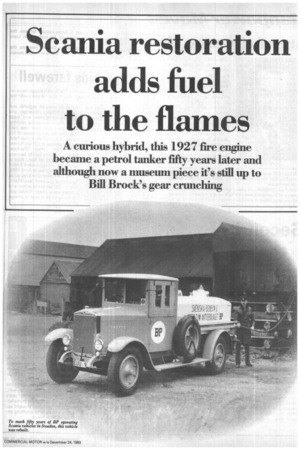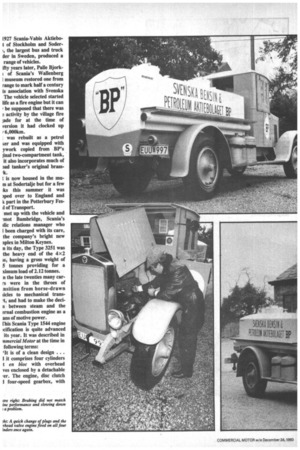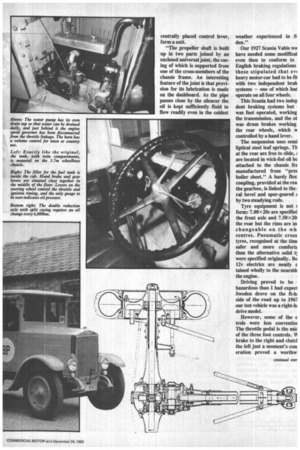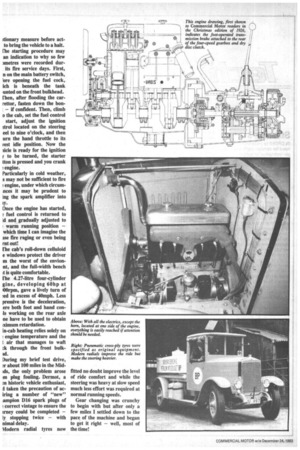Scania restoration adds fuel to the flames
Page 11

Page 12

Page 13

Page 14

If you've noticed an error in this article please click here to report it so we can fix it.
A curious hybrid, this 1927 fire engine became a petrol tanker fifty years later and although now a museum piece it's still up to Bill Brock's gear crunching
1927 Scania-Vabis Aktiebot of Stockholm and Soder', the largest bus and truck der in Sweden, produced a range of vehicles.
ifty years later, Palle Bjorkof Scania's Wallenberg i museum restored one from range to mark half a century ts association with Svenska The vehicle selected started life as a fire engine but it can r be supposed that there was activity by the village fire ;ade for at the time of version it had clocked up 76,000km.
was rebuilt as a petrol ier and was equipped with ywork copied from BP's flal two-compartment tank, it also incorporates much of )ad tanker's original brasst.
I is now housed in the mu m at Sodertalje but for a few ks this summer it was med over to England and k part in the Potterbury Fes[I of Transport.
met up with the vehicle and .mot Bambridge, Scania's gic relations manager who 1 been charged with its care, the company's bright new wlex in Milton Keynes.
n its day, the Type 3251 was the heavy end of the 4x2 is, having a gross weight of 5 tonnes providing for a ximum load of 2.12 tonnes. n the late twenties many carrs were in the throes of nsition from horse-drawn tides to mechanical trans.t, and had to make the decin between steam and the ernal combustion engine as a ans of motive power.
[his Scania Type 1544 engine .cification is quite advanced its year. It was described in wnercial Motor at the time in following terms: 'It is of a clean design . . . 1 it comprises four cylinders t en bloc with overhead ves enclosed by a detachable ,er. The engine, disc clutch I four-speed gearbox, with centrally placed control lever, form a unit.
"The propeller shaft is built up in two parts joined by an enclosed universal joint, the casing of which is supported from one of the cross-members of the chassis frame. An interesting feature of the joint is that provision for its lubrication is made on the dashboard. As the pipe passes close by the silencer the oil is kept sufficiently fluid to flow readily even in the coldest weather experienced in So den."
Our 1927 Scania Vabis wo have needed some modfficat even then to conform to English braking regulations these stipulated that evi heavy motor-car had to be fit with two independent brak systems — one of which had operate on all four wheels.
This Scania had two indep dent braking systems but was foot operated, working the transmission, and the ot was drum brakes working the rear wheels, which controlled by a hand lever.
The suspension uses semi liptical steel leaf springs. Th at the rear are free to slide, ; are located in wick-fed oil be attached to the chassis fro manufactured from "pres boiler sheet." A hardy flex: coupling, provided at the rea the gearbox, is linked to the rat bevel and spur-geared by two steadying rods.
Tyre equipment is not form; 7.00)< 20s are specified the front axle and 7.50 x the rear but the rims are in changeable on the wh centres. Pneumatic cross tyres, recognised at the timi safer and more comfortt than the alternative solid t] were specified originally. Bo 12v electrics are neatly c tamed wholly to the nearsid■ the engine.
Driving proved to be hazardous than I had expeci Sweden drove on the ft-lu side of the road up to 196'7 our test vehicle was a right-h: drive model.
However, some of the c trots were less conventioi The throttle pedal is the mid of the three foot controls. NI brake to the right and elute] the left just a moment's con: eration proved a worthw' itionary measure before actto bring the vehicle to a halt. [he starting procedure may an indication to why so few metres were recorded dur its fire service days. First, n on the main battery switch, ore opening the fuel cock, ich is beneath the tank tinted on the front bulkhead. Chen, after flooding the carrettor, fasten down the bon if confident. Then, climb o the cab, set the fuel control start, adjust the ignition itrol located on the steering eel to nine o'clock, and then urn the hand throttle to its vest idle position. Now the tide is ready for the ignition r to be turned, the starter tton is pressed and you crank engine.
Particularly in cold weather, s may not be sufficient to fire engine, under which circumnces it may be prudent to ing the spark amplifier into iy.
Once the engine has started, fuel control is returned to 41 and gradually adjusted to warm running position — which time I can imagine the use fire raging or even being rnt out!
[he cab's roll-down celluloid e windows protect the driver in the worst of the envionnt, and the full-width bench t is quite comfortable.
the 4.27-litre four-cylinder gine, developing 60hp at 100rpm, gave a lively turn of !ed in excess of 40mph. Less pressive is the deceleration, ere both foot and hand conIs working on the rear axle ne have to be used to obtain lximum retardation.
[n-cab heating relies solely on ! engine temperature and the air that manages to waft through the front bulk During my brief test drive, n. about 100 miles in the Mid. ids, the only problem arose rn plug fouling. Dermot, a !II historic vehicle enthusiast, taken the precaution of aciring a number of "new" ampion D16 spark plugs of correct vintage to ensure the irney could be completed — Ey stopping twice — with nimal delay.
Vlodern radial tyres now fitted no doubt improve the level of ride comfort and while the steering was heavy at slow speed much less effort was required at normal running speeds.
Gear changing was crunchy to begin with but after only a few miles I settled down to the pace of the machine and began to get it right — well, most of the time!




















































